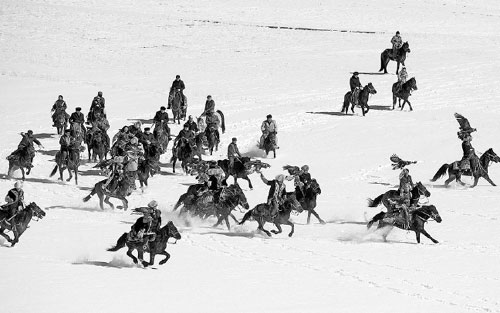Snow draws millions to Xinjiang
Updated: 2016-02-23 08:04
By Cui Jia and Mao Weihua in Urumqi(China Daily)
|
||||||||
Improvements help people get to previously inaccessible areas during the colder months
A few years ago, the Xinjiang Uygur autonomous region, which draws hordes of tourists in summer and autumn, typically turned quiet when the long winter arrived.
Now more people are choosing to experience the region's grand natural scenery and diverse ethnic cultures during the coldest months of the year.
The region is expected to attract 24 million tourists between November and April, a 62 percent increase over the previous winter. About 900,000 tourists visited Xinjiang during the winter of 2006, according to Li Jidong, Party chief of the regional tourism bureau.
"For Xinjiang, heavy snowfall in winter is no longer a burden. It has been turned into a gold mine. We have combined winter sightseeing, winter sports and unique ethnic cultures to create multiple layers of experiences for tourists," Li said.
The region has also improved its transportation infrastructure to make travel easier. Roads to popular nature sites in Xinjiang, once sealed off by heavy snow in winter, have become accessible with better road conditions and the acquisition of world-class snow-clearing equipment.
As one of the top natural attractions in China, the Kanas Valley sits beside the Altay Mountains, renowned for beautiful rivers fed by Kanas Lake. Before 2014, the mountain roads could be used by tourists only between May and October.
After the area's roads were widened and could be quickly cleared of snow, visitors were able to take in the breathtaking winter during the cheaper offseason.
Ski enthusiasts around China are drawn to Xinjiang's snow, sunshine, ski resorts and hot springs. According to Li Wei, deputy director of the regional tourism bureau, Xinjiang started to promote winter tourism in 2000 and has since built 28 ski resorts.
Hosting the 13th National Winter Games in January, the region showcased its top winter sports facilities and is poised to attract more visitors in the future.
"We received 33,000 tourists last week, marking a 20 percent growth over the same period last year," said Huang He, marketing director of Silk Road International Ski Resort, a venue for the Winter Games. "Ski fans from all over the country chose to spend their Spring Festival in a new way."
In 2015, the regional government invested 20 million yuan ($3 million) in incentives for travel agencies to attract tourists to Xinjiang. The agencies received 50 yuan for every tourist they brought to Xinjiang from other parts of China. The incentive was 15 yuan in 2014.
Besides the stunning natural views and winter sports facilities, tourists also enjoy Xinjiang's diverse ethnic cultural activities, some of which can only been experienced in winter, Li Jidong said.
Xinjiang is home to people from 13 ethnic groups and each has a special way to enjoy the winter. People can stay with the Tuvans in their pointed houses in Kanas, for example, and try on skis made from pine trees and horse fur. They can also watch the Kazaks and their Golden Eagles catch rabbits in the snow in a hunting competition that is only held in the winter.
Xinhua contributed to this story.
Contact the writers at cuijia@chinadaily.com.cn
|
Local Kazak herdsmen participate in a traditional hunting competition for rabbits or foxes on horseback with eagles that they have trained for years, in Yining, Xinjiang Uygur autonomous region, on Thursday. Qin Jie / for China Daily |
(China Daily 02/23/2016 page5)

 The world in photos: Feb 15 - 21
The world in photos: Feb 15 - 21
 China Daily weekly pictures: Feb 13-19
China Daily weekly pictures: Feb 13-19
 Lantern Festival in the Chinese paintings
Lantern Festival in the Chinese paintings
 Meet Melanie, the real-life mermaid
Meet Melanie, the real-life mermaid
 Samsung unveils new products at mobile conference in Spain
Samsung unveils new products at mobile conference in Spain
 88th Academy Awards Governors Ball Press Preview
88th Academy Awards Governors Ball Press Preview
 Chinese photographers' work shines in major photo contest
Chinese photographers' work shines in major photo contest
 Egg carving master challenges Guinness World Record
Egg carving master challenges Guinness World Record
Most Viewed
Editor's Picks

|

|

|

|

|

|
Today's Top News
What ends Jeb Bush's White House hopes
Investigation for Nicolas's campaign
Will US-ASEAN meeting be good for region?
Accentuate the positive in Sino-US relations
Dangerous games on peninsula will have no winner
National Art Museum showing 400 puppets in new exhibition
Finest Chinese porcelains expected to fetch over $28 million
Monkey portraits by Chinese ink painting masters
US Weekly

|

|









